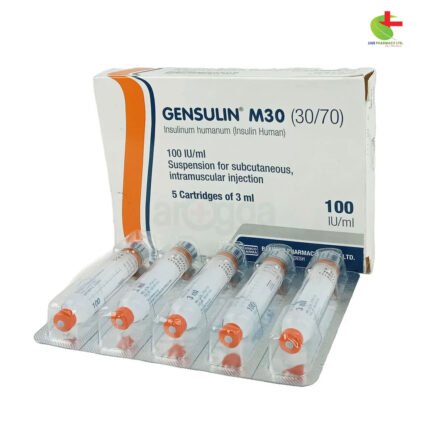

Reglutide
5,000.00৳ 1.34 mg/ml
- Reglutide: A GLP-1 receptor agonist used to manage type 2 diabetes and chronic obesity.
- For Diabetes: Enhances glycemic control and reduces cardiovascular event risk in adults.
- For Obesity: Assists in weight management alongside diet and exercise for patients with high BMI or weight-related conditions.
- Administration: Available as a daily tablet or weekly injection, tailored to individual needs.
 Brand
Brand
|
Beximco Pharmaceuticals Ltd |
|---|---|
 Generics
Generics
|
Semaglutide |
 Type
Type
|
SC Injection |
Indications for Reglutide
For Diabetes Management: Reglutide is prescribed to:
- Support glycemic control in adults with type 2 diabetes mellitus when used alongside diet and exercise.
- Lower the risk of major cardiovascular events in adults with type 2 diabetes and pre-existing cardiovascular disease.
For Obesity Treatment: Reglutide is recommended as part of a comprehensive weight management program, including a reduced-calorie diet and increased physical activity, for adults with an initial Body Mass Index (BMI) of:
- 30 kg/m² or greater (Obesity), or
- 27 kg/m² or greater (Overweight) with at least one weight-related condition (e.g., hypertension, type 2 diabetes, or dyslipidemia).
Pharmacology
Semaglutide, a GLP-1 analogue, mirrors human GLP-1 with a 94% sequence match. It functions as a GLP-1 receptor agonist, activating the GLP-1 receptor to reduce blood glucose levels in a glucose-dependent manner. This is achieved by stimulating insulin secretion and suppressing glucagon secretion when glucose levels are elevated, and slightly delaying gastric emptying. In cases of hypoglycemia, Semaglutide reduces insulin secretion without affecting glucagon levels. Additionally, it aids in weight and fat reduction by curbing overall appetite.
Dosage & Administration:
For Diabetes:
Semaglutide Tablet:
- Starter Dose: 3 mg once daily for 30 days, taken at least 30 minutes before the first meal or other oral medications, with up to 4 ounces (118 ml) of plain water.
- Maintenance Dose: After 30 days, increase to 7 mg daily.
- Additional Glycemic Control: If needed, increase to 14 mg daily after at least 30 days on the 7 mg dose.
Semaglutide Injection:
- Initial Dose: 0.25 mg once weekly. After 4 weeks, increase to 0.5 mg weekly. Following at least 4 weeks on 0.5 mg, increase to 1 mg weekly if further glycemic control is required. Weekly doses above 1 mg are not recommended.
- Administration: Inject subcutaneously in the abdomen, thigh, or upper arm. The injection site can be varied without dose adjustment. Weekly dosing day can be adjusted, provided the interval between doses is at least 3 days (>72 hours).
Switching Between Semaglutide Injection and Tablet:
- Transition from 0.5 mg weekly injection to 7 mg or 14 mg daily tablet up to 7 days after the last injection. There is no direct equivalent for the 1 mg injection.
- Transition from 14 mg daily tablet to 0.5 mg weekly injection the day after the last tablet dose.
For Obesity:
Semaglutide Injection:
- Starting Dose: 0.25 mg once weekly for 4 weeks. If dose escalation causes intolerance, delay by 4 weeks. If 2.4 mg maintenance dose is not tolerated, temporarily reduce to 1.7 mg for up to 4 weeks, then increase to 2.4 mg. Weekly doses above 2.4 mg are not recommended.
- Administration: Inject subcutaneously in the abdomen, thigh, or upper arm. The dosing day can be changed as long as the interval between doses is at least 2 days (>48 hours).
Interactions:
Reglutide may delay gastric emptying, potentially affecting the absorption rate of other oral medications. Use with caution in patients on medications that require rapid gastrointestinal absorption.
Contraindications:
- Hypersensitivity to Semaglutide or any excipients.
Side Effects:
- Possible hypoglycemia when used with insulin or sulfonylureas. Common adverse reactions include gastrointestinal issues (nausea, diarrhea, vomiting, abdominal pain, constipation), which are typically mild to moderate. Other reactions may include allergic responses, injection site reactions, lipodystrophy, pruritus, and rash.
Pregnancy & Lactation:
- Not recommended during pregnancy. Discontinue at least 2 months before planned pregnancy. Not recommended during breastfeeding due to potential risk to the infant.
Precautions & Warnings:
- Diabetic Ketoacidosis: Not for use in type 1 diabetes or diabetic ketoacidosis.
- Pancreatitis: Discontinue if pancreatitis is suspected and do not restart if confirmed.
- Diabetic Retinopathy: Monitor patients with diabetic retinopathy.
Use in Special Populations:
- Pediatric: Safety and efficacy in individuals under 18 have not been established.
- Elderly: No dose adjustment required based on age.
- Renal Impairment: No dose adjustment for mild to severe renal impairment; not recommended for end-stage renal disease.
- Hepatic Impairment: No dose adjustment required; exercise caution.
Overdose Effects:
- Up to 4 mg single dose and weekly dose reported. Common reaction: nausea. No specific antidote; supportive treatment should be based on clinical symptoms.
Dose Adjustment:
- When adding to existing metformin or thiazolidinedione therapy, continue current doses. When adding to sulfonylurea or insulin therapy, consider dose reduction to avoid hypoglycemia. Blood glucose self-monitoring is needed to adjust sulfonylurea and insulin doses.
Missed Dose:
- Administer as soon as possible within 5 days of missing a dose. If more than 5 days, skip the missed dose and continue with the regular schedule.
Therapeutic Class:
- GLP-1 Receptor Agonists
Storage Conditions:
- Store between 2°C and 8°C (refrigerated). Do not freeze. Keep out of reach of children.











Reviews
There are no reviews yet.